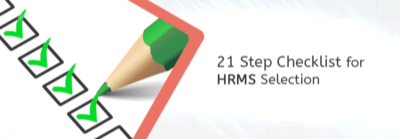You are mostly reading this because you are currently tasked with a very critical responsibility. You are looking out for selecting an HRMS tool that is best suited for your organization. Yes and to confound you more, you search on Google, and you see at least 10 vendors that claim to be the best in the business. They might be the best, but the more pertinent question is - what is the best one for you? Now is when a tried and tested handy checklist which will guide you through this process comes into the picture. Be it a 25 member organization or a 300 member organization; this checklist is all it takes to have a fool-proof approach and guaranteed success to an HRMS selection.
Top 3 concerns that you might want to be aware right off:
- Your current HR process and how an HRMS tool can map this accurately and also introduce best practices so that it is easily adopted in your organization
- Technology being used and whether it is the most updated and can it scale as you grow as an organization
- Ease of use for your current users and how well they get acclimated to this change in process and software
Using a tried and tested approach to the selection process is the best way to avoid uncertainties and going off budget meanwhile landing up with a failed implementation.
The 3 most important questions that you will have to answer in the future post an HRMS implementation are:
- How has the HRMS system improved the productivity in your organization?
- Has the return on investment been justified?
- Was this the right HR software for your organization?
Most organizations never even think of asking these questions to themselves, and it is an easy way to end up in the wrong place.
Why a checklist:
Most organizations go wrong because of the lack of a structured approach to this selection process. The checklist provides the most important steps that will help you to make an informed decision. All the critical steps are covered in this exhaustive list, but you may still wish to have it trimmed to suit your need better. It lets you pick and chose the steps which are relevant and applicable to you and in the specific order so that you can do this as a smart as it can get. You can have your best HRMS solution, up and running at the specified time and within your budget.
Our tried and tested checklist which has been curated by our experience of working with our 5000 plus customers is sure to be your best guide in this selection process.
The checklist can be broken up into 7 critical high-level tasks with associated activities under each of these. It has been broken into easy steps which you can adapt to your need.
The high-level key tasks mentioned in this are:
- Selection team
- Requirements gathering with User groups
- System specification
- Vendor services
- Return on investment forecast
- Vendor shortlisting
- Vendor selection
We will now go into a bit of detail on each of these points to understand it better. It will also help you to understand the relevance of each of these tasks and why it matters.
Selection Team
One observation is that working as a team with a clear objective gives more focus and better results. You might get the best inputs from unexpected corners. So be open to all suggestions and let the force be with you.
- Select an HRMS selection project lead and a C-Level executive to sponsor your project
- Identify key stakeholders(user groups) including operational HR staff, HR management and employees outside of HR
Requirements Gathering with User groups
The User group plays a vital role here as it helps you to get a buy-in from the potential users of the system from a very early stage. As they feel part of the selection process, the resistance to change or to accept a foreign system can be removed by following this process.
- Create a map of current HR processes with cycle-times to identify bottlenecks affecting efficiency
- Identify paper-based HR process and shortcomings of existing HR systems
- Identify critical operational challenges you aim to solve with the new HRMS System
System Specification
This might sound a bit technical, but it is to see how and who will use the tool in their daily operations. The key here is the users who will either make or break any system. It is easy to implement any tool, but the success lies in the actual adoption and proper usage of the system.
- Identify the total number of users who will require system access
- Determine preferred delivery platform (cloud, on-premise, hybrid, etc.)
- Identify mobile access requirements (web-app, native iOS, native Android, etc.)
Vendor Services
It is essential that you get a better insight into the profile of the vendor that you would want to work with. This is really relevant if you see that Customer Support, User Training( Customer Success) and Data Security & Reports are the operational aspects of making the system a success. Be very clear on this aspect, and it can almost reduce your risks by 90%.
9. Document requirements for support scope and delivery method (phone support, online support, etc.)
10. Document requirements for training scope and delivery method (classroom training, on-site training)
11. Document data migration requirements for critical data and reports
Return on Investment Forecast
ROI will be of interest to your top management. ROI can also be entirely subjective, and it is better to have clarity on this from the beginning.
- Identify preferred payment method (SaaS, perpetual license, etc.)
- Compute ROI: consider TCO, return calculations, value addition, time & cost savings
- Report on ROI forecasts to senior management and seek project approval
If you have the above ready, then you are now very well placed to reach out to vendors and start your selection process. You have better clarity on what is that you need and it will help you to quickly choose between offerings which might have otherwise felt very compelling.
Vendor Shortlisting
Now you can look for the various options in the market. You can reach out to your colleagues/ peers in the similar industry. You can also do a relevant google search or try some of the more prominent software aggregators in the market (softwaresuggest) etc. who will provide you with a list of software available in the market along with reviews and ratings.
- Identify HRMS vendors who meet your critical requirements and send them an RFI document
- Compile requirements based on RFI responses and business processes into an RFP document
- Narrow shortlist based on RFP responses to produce final shortlist
Vendor Selection
You are almost there now, and this is when teamwork and communication plays a huge role. You need to evaluate the pro-cons of each of the vendors and look at the best solution from a long-term perspective.
- Build selection teams to attend software demo including user group members
- Produce an RFQ document and send to all vendors that were demoed including a request for 2/3 references
- Assemble selection committee to review and finalize the vendor
- Proceed to contract negotiations
One of the things that we have seen with our customers is that the more you use the tool, the more insights you gain and the better you get at improving the processes. It is almost always an ongoing process, and especially the cloud-based HRMS vendors are aggressively launching new upgrades and features at a very accelerated pace. This is good for you as you will stand to benefit more from an ever-evolving product that better meets your requirement as well as keeps adapting itself to the ever-changing trends in HR.
One other important point on statutory compliance: all HRMS vendors have to be 100% statutory compliant to be relevant in the market. This is what differentiates the true market leaders from the also-rans.
You can download the excel version of this checklist for your selection process here.
How will an HRMS help you?
All systems HRMS have been based on the principles and functions of HR and try to have in-built systems in place so that you don’t have to create a new process around it. All HRMS replicate this in a structured way, and it is configured such that it can be tweaked to meet your specific needs. You will have a lot of flexibility especially with the present cloud-based systems which will let you do a lot of customization.
Case study
If you want to know how it works for real, we have something for you.
Here is a case study on how Versatile Tech choose greytHR as their HRMS vendor









